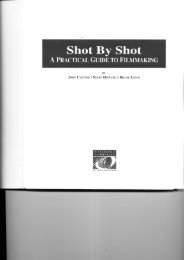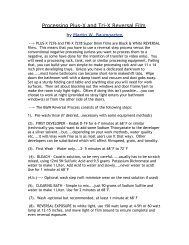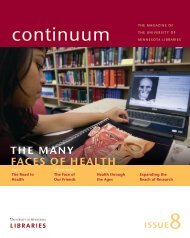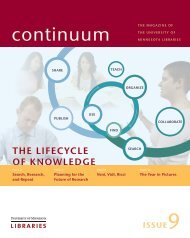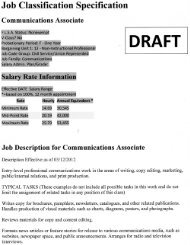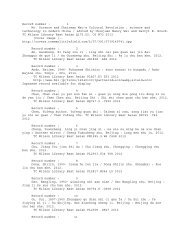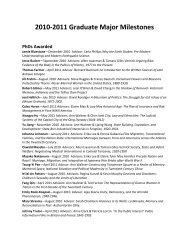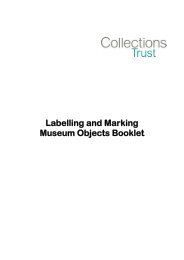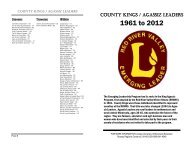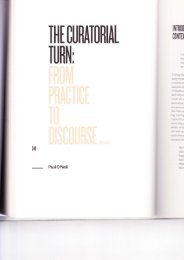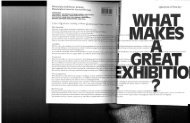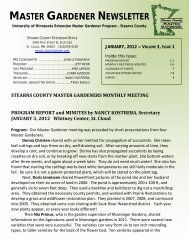Art in the Information Age: Technology and Conceptual Art
Art in the Information Age: Technology and Conceptual Art
Art in the Information Age: Technology and Conceptual Art
Create successful ePaper yourself
Turn your PDF publications into a flip-book with our unique Google optimized e-Paper software.
tiques of art <strong>in</strong>stitutions <strong>and</strong> <strong>in</strong>dustry, his<br />
work <strong>in</strong> <strong>the</strong> early 1960s evolved from k<strong>in</strong>etic<br />
sculpture <strong>and</strong> was <strong>in</strong>cluded <strong>in</strong> a<br />
number of key Nouvelle Tendence exhibitions.<br />
These early works were predicated<br />
on <strong>the</strong> dynamism of natural<br />
systems, an idea that was <strong>in</strong>tegral to diverse<br />
stra<strong>in</strong>s of process <strong>and</strong> conceptual<br />
art, as well as to art-<strong>and</strong>-technology.<br />
Haacke considered himself a “sort of junior<br />
partner” of <strong>the</strong> German-based Zero<br />
group [11], renowned for <strong>the</strong>ir sky <strong>and</strong><br />
light works of <strong>the</strong> late 1950s. The Howard<br />
Wise Gallery, <strong>the</strong> premier commercial<br />
venue for <strong>the</strong> presentation of art-<strong>and</strong>technology,<br />
gave Haacke solo exhibitions<br />
<strong>in</strong> 1966, 1968 <strong>and</strong> 1969.<br />
A close friend of Burnham s<strong>in</strong>ce 1962,<br />
Haacke contributed two pieces to <strong>the</strong><br />
Software exhibition: News <strong>and</strong> Visitor’s Pro-<br />
le. These works were part of <strong>the</strong> artist’s<br />
Real Time Systems series, <strong>in</strong>spired <strong>in</strong> part<br />
by conversations with Burnham, who <strong>in</strong>troduced<br />
Haacke to <strong>the</strong> idea of open biological<br />
systems developed by Ludwig<br />
Von Bertalanffy <strong>and</strong> to Norbert Wiener’s<br />
<strong>the</strong>ories of cybernetics. Burnham’s article<br />
“Real Time Systems” differentiated<br />
between “ideal time” <strong>and</strong> “real time” with<br />
respect to art, a dist<strong>in</strong>ction that Haacke<br />
applied to his work. In ideal time, <strong>the</strong> aes<strong>the</strong>tic<br />
contemplation of beauty occurs <strong>in</strong><br />
<strong>the</strong>oretical isolation from <strong>the</strong> temporal<br />
cont<strong>in</strong>gencies of value; while <strong>in</strong> real time,<br />
value accrues on <strong>the</strong> basis of an immediate,<br />
<strong>in</strong>teractive, <strong>and</strong> necessarily cont<strong>in</strong>gent<br />
exchange of <strong>in</strong>formation.<br />
News (1969) <strong>in</strong>corporated several Teletype<br />
mach<strong>in</strong>es that delivered a perpetual<br />
ow of <strong>in</strong>formation about local, national<br />
<strong>and</strong> <strong>in</strong>ternational events, pr<strong>in</strong>ted out on<br />
cont<strong>in</strong>uous rolls of paper <strong>in</strong> real time.<br />
The computerized Visitor’s Prole planned<br />
for Software was more technologically<br />
sophisticated than <strong>the</strong> manual version<br />
<strong>in</strong>stalled at <strong>the</strong> <strong>Information</strong> exhibition<br />
<strong>the</strong> same year. The computer was programmed<br />
to <strong>in</strong>stantaneously cross-tabulate<br />
demographic <strong>in</strong>formation about <strong>the</strong> museum<br />
audience (age, sex, education <strong>and</strong><br />
so on) with <strong>the</strong>ir op<strong>in</strong>ions on a variety<br />
of provocative subjects, rang<strong>in</strong>g from<br />
“Should <strong>the</strong> use of marijuana be legalized,<br />
lightly or severely punished?” to “Assum<strong>in</strong>g<br />
you were Indoch<strong>in</strong>ese, would you<br />
sympathize with <strong>the</strong> present Saigon<br />
regime?” [12] Whereas <strong>the</strong> statistical data<br />
from <strong>the</strong> o<strong>the</strong>r versions of Visitor’s Prole<br />
were tabulated on a daily basis, <strong>the</strong> Software<br />
version was designed to perform<br />
<strong>the</strong>se calculations <strong>in</strong> real time. As Haacke<br />
noted <strong>in</strong> his artist’s statement:<br />
The process<strong>in</strong>g speed of <strong>the</strong> computer<br />
makes it possible that at any given time<br />
<strong>the</strong> statistical evaluation of all answers is<br />
up to date <strong>and</strong> available. The constantly<br />
chang<strong>in</strong>g data is projected onto a large<br />
screen, so that it is accessible to a great<br />
number of people. Based on <strong>the</strong>ir own<br />
<strong>in</strong>formation a statistical prole of <strong>the</strong> exhibition’s<br />
visitors emerges [13].<br />
Like Lev<strong>in</strong>e, Haacke did not use technology<br />
as an end <strong>in</strong> itself, but ra<strong>the</strong>r put<br />
it <strong>in</strong> <strong>the</strong> service of <strong>the</strong> ideas that were central<br />
to his artistic practice. As <strong>in</strong> earlier<br />
technologically enhanced works by<br />
Haacke, such as Photo-Electric Viewer-<br />
Programmed Coord<strong>in</strong>ate System (1966–1968),<br />
technology was employed as a means to<br />
enable art to become a responsive, realtime<br />
system that “merges with <strong>the</strong> environment<br />
<strong>in</strong> a relationship that is better<br />
understood as a ‘system’ of <strong>in</strong>terdependent<br />
processes” [14]. Similarly, <strong>in</strong> <strong>the</strong><br />
Software version of Visitor’s Prole, a computer<br />
received, processed <strong>and</strong> distributed<br />
<strong>in</strong>formation <strong>in</strong>stantaneously so that <strong>the</strong><br />
piece could <strong>in</strong>teract with participants <strong>in</strong><br />
real time by responsively ga<strong>the</strong>r<strong>in</strong>g <strong>and</strong><br />
evaluat<strong>in</strong>g <strong>in</strong>formation about <strong>the</strong> systematic<br />
relationship between art <strong>and</strong> society.<br />
In this regard, Haacke’s work shares<br />
common concerns with <strong>the</strong> conceptual<br />
goals underly<strong>in</strong>g <strong>the</strong> work of many artists<br />
associated with art-<strong>and</strong>-technology, <strong>in</strong>clud<strong>in</strong>g<br />
Nicolas Schöffer’s CYSP series of<br />
cybernetic sculptures of <strong>the</strong> mid-1950s,<br />
James Seawright’s <strong>in</strong>teractive robotic<br />
sculptures beg<strong>in</strong>n<strong>in</strong>g <strong>in</strong> <strong>the</strong> mid-1960s,<br />
Sonia Sheridan’s found<strong>in</strong>g of <strong>the</strong> Generative<br />
Systems program at <strong>the</strong> School of<br />
<strong>the</strong> <strong>Art</strong> Institute of Chicago <strong>in</strong> 1970,<br />
Myron Kreuger’s “articial reality” environments<br />
beg<strong>in</strong>n<strong>in</strong>g <strong>in</strong> <strong>the</strong> early 1970s<br />
<strong>and</strong> <strong>the</strong> veritable explosion of art comb<strong>in</strong><strong>in</strong>g<br />
computers <strong>and</strong> telecommunications<br />
s<strong>in</strong>ce 1980.<br />
Like Lev<strong>in</strong>e <strong>and</strong> Haacke, Joseph Kosuth<br />
also has utilized mass media as a<br />
component <strong>in</strong> his work. However, unlike<br />
those artists, Kosuth has not made explicit<br />
use of technology such as video,<br />
computers or telecommunications.<br />
None<strong>the</strong>less, <strong>the</strong> technological metaphor<br />
of <strong>in</strong>formation process<strong>in</strong>g offers an<br />
<strong>in</strong>sightful model for <strong>in</strong>terpret<strong>in</strong>g his<br />
work. His contribution to Software, <strong>the</strong><br />
Seventh Investigation (<strong>Art</strong> as Idea as Idea)<br />
Proposition One (1970), <strong>in</strong>cluded <strong>the</strong> same<br />
pr<strong>in</strong>ted text <strong>in</strong> various <strong>in</strong>ternational contexts:<br />
a billboard <strong>in</strong> English <strong>and</strong> Ch<strong>in</strong>ese<br />
<strong>in</strong> <strong>the</strong> Ch<strong>in</strong>atown neighborhood of lower<br />
Manhattan, an advertisement <strong>in</strong> The Daily<br />
World <strong>and</strong> a banner <strong>in</strong> Tur<strong>in</strong>. The text<br />
comprised a set of six propositions:<br />
(1) to assume a mental set voluntarily<br />
(2) to shift voluntarily from one aspect<br />
of <strong>the</strong> situation to ano<strong>the</strong>r<br />
(3) to keep <strong>in</strong> m<strong>in</strong>d simultaneously<br />
various aspects<br />
(4) to grasp <strong>the</strong> essential of a given<br />
whole; to break up a given whole <strong>in</strong>to<br />
parts <strong>and</strong> to isolate <strong>the</strong>m voluntarily<br />
(5) to generalize; to abstract common<br />
properties; to plan ahead ideationally; to<br />
assume an attitude toward <strong>the</strong> “mere possible”<br />
<strong>and</strong> to th<strong>in</strong>k or perform symbolically<br />
(6) to detach our ego from <strong>the</strong> outer<br />
world<br />
Kosuth’s statement <strong>in</strong> <strong>the</strong> Software catalog<br />
emphasized his <strong>in</strong>tention that <strong>the</strong><br />
work not be reducible to a mental image,<br />
but that it exist as <strong>in</strong>formation free of any<br />
iconography: “The art consists of my action<br />
of plac<strong>in</strong>g this activity (<strong>in</strong>vestigation)<br />
<strong>in</strong> an art context (i.e. art as idea as idea)”<br />
[15].<br />
Accord<strong>in</strong>g to <strong>the</strong> software metaphor<br />
underly<strong>in</strong>g Burnham’s exhibition, <strong>the</strong> art<br />
<strong>in</strong> Kosuth’s work was not <strong>the</strong> billboard or<br />
<strong>the</strong> o<strong>the</strong>r structural elements (hardware),<br />
but was manifested ra<strong>the</strong>r <strong>in</strong> <strong>the</strong><br />
idea of contextualiz<strong>in</strong>g philosophical<br />
questions (software) with<strong>in</strong> <strong>the</strong> context<br />
of visual art <strong>and</strong> simultaneously decontextualiz<strong>in</strong>g<br />
<strong>the</strong>m <strong>in</strong> various public, nonart<br />
media. In this way, his work<br />
<strong>in</strong>vestigated <strong>the</strong> relationship between art<br />
<strong>and</strong> non-art ideas, <strong>the</strong> vehicles by which<br />
<strong>the</strong>y are expressed, <strong>and</strong> <strong>the</strong> semiotic networks<br />
that enable <strong>and</strong> delimit <strong>the</strong>ir<br />
mean<strong>in</strong>gs <strong>in</strong> multiple contexts.<br />
Apply<strong>in</strong>g <strong>the</strong> parallel Burnham drew—<br />
between how computer software controls<br />
<strong>the</strong> hardware that runs it <strong>and</strong> how <strong>in</strong>formation<br />
directs <strong>the</strong> activity of <strong>the</strong> human<br />
m<strong>in</strong>d—to Kosuth’s work, one can <strong>in</strong>terpret<br />
<strong>the</strong> artist’s propositions as operat<strong>in</strong>g<br />
like <strong>in</strong>structions <strong>in</strong> <strong>the</strong> m<strong>in</strong>d of <strong>the</strong><br />
viewer. But whereas computer software<br />
has an <strong>in</strong>strumental relationship with<br />
hardware, coord<strong>in</strong>at<strong>in</strong>g its operation, <strong>the</strong><br />
artist’s propositions function as metaanalyses<br />
of <strong>the</strong> phenomenological <strong>and</strong><br />
l<strong>in</strong>guistic components of mean<strong>in</strong>g. In<br />
o<strong>the</strong>r words, <strong>the</strong>y dem<strong>and</strong> that <strong>the</strong> viewer<br />
exam<strong>in</strong>e <strong>the</strong> process of process<strong>in</strong>g <strong>in</strong>formation,<br />
while <strong>in</strong> <strong>the</strong> process of do<strong>in</strong>g so.<br />
Although Kosuth did not explicitly<br />
draw on computer models of <strong>in</strong>formation<br />
process<strong>in</strong>g, his <strong>in</strong>vestigations follow<br />
similar modes of logic, while at <strong>the</strong> same<br />
time dem<strong>and</strong><strong>in</strong>g a self-reexivity that exceeds<br />
computational systems. By pos<strong>in</strong>g<br />
propositions that required viewers to <strong>in</strong>vestigate<br />
<strong>the</strong> cognitive function<strong>in</strong>g of<br />
<strong>the</strong>ir own m<strong>in</strong>ds with respect to <strong>the</strong> process<strong>in</strong>g<br />
of <strong>in</strong>formation <strong>and</strong> <strong>the</strong> creation<br />
of mean<strong>in</strong>g, Kosuth’s Seventh Investigation<br />
sought to <strong>in</strong>terrogate how <strong>and</strong> why what<br />
he called <strong>the</strong> “language game” of art<br />
functioned <strong>in</strong> a larger cultural framework.<br />
This critical project reects <strong>the</strong><br />
shift from an <strong>in</strong>dustrial to a post-<br />
Shanken, <strong>Art</strong> <strong>in</strong> <strong>the</strong> <strong>Information</strong> <strong>Age</strong> 435<br />
S<br />
I<br />
G<br />
G<br />
R<br />
A<br />
P<br />
H<br />
A<br />
R<br />
T<br />
A<br />
N<br />
D<br />
C<br />
U<br />
L<br />
T<br />
U<br />
R<br />
E



